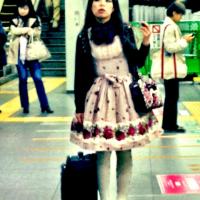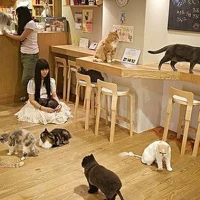
Cosplay (コスプレ kosupure), short for “costume play“, is an activity in which participants wear costumes and accessories to represent a specific character or idea from a work of fiction. Cosplayers often interact to create a subculture centered on role play. A broader use of the termcosplay applies to any costumed role play in venues apart from the stage, regardless of the cultural context.
Favorite sources include manga, anime, comic books, video games, and films. Any entity from the real or virtual world that lends itself to dramatic interpretation may be taken up as a subject. Inanimate objects are given anthropomorphic forms and it is not unusual to see genders switched, with women playing male roles and vice versa. There is also a subset of cosplay culture centered on sex appeal, with cosplayers specifically choosing characters that are known for their attractiveness and/or revealing costumes.
Cosplay costumes vary greatly and can range from simple themed clothing to highly detailed costumes. Cosplay is generally considered different from Halloween and Mardi Gras costume wear, as the intention is to accurately replicate a specific character, rather than to reflect the culture and symbolism of a holiday event. As such, when in costume, cosplayers will often seek to adopt the affect, mannerisms and body language of the characters they portray (with “out of character” breaks). The characters chosen to be cosplayed may be sourced from any movies, TV series, books, comic books, video games or music bands, but the practice of cosplay is often associated with replicating anime and manga characters.
Most cosplayers create their own outfits, referencing images of the characters in the process. In the creation of the outfits, much time is given to detail and qualities, thus the skill of a cosplayer may be measured by how difficult the details of the outfit are and how well they have been replicated. Because of the difficulty of replicating some details and materials, cosplayers often educate themselves in crafting specialties such as textiles, sculpture, face paint, fiberglass, fashion design, woodworking and other uses of materials in the effort to render the look and texture of a costume accurately. Cosplayers often wear wigs in conjunction with their outfit in order to further improve the resemblance to the character. This is especially necessary for anime and manga characters who often have unnaturally coloured and uniquely styled hair. Simpler outfits may be compensated for their lack of complexity by paying attention to material choice, and overall excellent quality. The process of creation may then be very long and time-consuming, making it a very personal journey and achievement for many. This taxing and often expensive process is known to unite cosplayers and is considered a part of the culture of cosplay.
Cosplayers obtain their apparel through many different methods. Manufacturers produce and sell packaged outfits for use in cosplay, in a variety of qualities. These costumes are often sold online, but also can be purchased from dealers at conventions. There are also a number of individuals who work on commission, creating custom costumes, props or wigs designed and fitted to the individual; some social networking sites for cosplay have classified ad sections where such services are advertised. Other cosplayers, who prefer to create their own costumes, still provide a market for individual elements, accessories, and various raw materials, such as unstyled wigs or extensions, hair dye, cloth and sewing notions, liquid latex, body paint, shoes, costume jewellery and prop weapons. Some anime and video game characters have weapons or other accessories that are hard to replicate, and conventions have strict rules regarding those weapons, but most cosplayers engage in some combination of methods to obtain all the items necessary for their costume; for example, they may commission a prop weapon, sew their own clothing, buy character jewelry from a cosplay accessory manufacturer, buy a pair of off-the-rack shoes, and modify them to match the desired look.
In order to look more like the character they are portraying, many cosplayers also engage in various forms of body modification. Contact lenses that match the color of their character’s eyes are a common form of this, especially in the case of characters with particularly unique eyes as part of their trademark look. Contact lenses that make the pupil look enlarged to visually echo the large eyes of anime and manga characters are also used.[4] Another form of body modification that cosplayers engage in is to copy any tattoos or special markings that their character might have. Temporary tattoos, permanent marker, body paint and, in rare cases, permanent tattoos, are all methods used by cosplayers to achieve the desired look. Permanent and temporary hair dye, spray-in hair coloring, and specialized extreme styling products are all utilized by some cosplayers whose natural hair can achieve the desired hairstyle.
Purpose
The Psychology of Cosplay panel at the 2012
New York Comic Con. From left to right: Psychologist Dr. Andrea Letamendi, journalist/cosplayer Jill Pantozzi, costume designer/cosplayer Holly Conrad, who appeared in the film
Comic-Con Episode IV-A Fan’s Hope, and Bill Doran, who runs the cosplay business Punished Props.
The cosplayer’s purpose may generally be sorted into one of three categories, or a combination of the three. Most cosplayers draw characteristics from all three categories:
- The first is to express adoration for a character, or in feeling similar to a character in personality, seeking to become that character. This type of cosplayer may be associated with being a fan and is often labeled as an otaku. Other characteristics may be an enthusiastic manner and less attention to detail and quality. Such cosplayers are also most likely to adopt the character’s personality and are known to criticise other cosplayers for not having a full knowledge of their character, or not also adopting character mannerisms.
- The second is those people who enjoy the attention that cosplaying a certain character brings. Within the cultures of anime and manga specifically, as well as science fiction and fantasy, there is a certain level of notoriety that is attached to cosplayers. Such cosplayers are usually characterised by attention to detail in their garments and their choice of popular characters. They are also noted by participation in cosplay competitions.
- The third is those who enjoy the creative process, and the sense of personal achievement upon completion. Such people are more likely to have a greater budget dedicated to the project, more complicated and better quality outfits with access to more materials. They are also more likely to engage with professional photographers and cosplay photographers to take high quality images of the cosplayer in their garment posing as the character.
Photography
Some cosplayers choose to have a cosplay photographer take high quality images of them in their costumes posing as the character. This is most likely to take place in a setting relevant to the character’s origin, such as churches, parks, forests, water features and abandoned/run-down sites. Such cosplayers are likely to exhibit their work online, on blogs (such as tumblr), social networking services (such as Facebook), or artist websites (such as deviantART). They may also choose to sell such images or print the images as postcards and give them as gifts. What is more, some cosplayers choose to take photos themselves and become cosplay photographers too.

Marika Oyama shows her self-made props for cosplay photo shoots at her Studio Angle in the Marunouchi area of Okayama’s Kita Ward.
Marika Oyama turned the hobby she loved into a full-fledged business.
Cosplay fans in the Okayama city area in Okayama Prefecture and beyond flock to her special photo studio that helps them with costumes, makeup and props as they portray their favorite anime and manga characters.
The 27-year-old Oyama had no previous business experience, but she took a monthlong course in entrepreneurship before opening Studio Angle in January in the Marunouchi area of Kita Ward.
Studio Angle has become a real success story, and Oyama says she has found repeat customers in and out of the prefecture.
Studio Angle is housed in a building near the prefectural government office. The studio comprises two rooms, one white, one black. Each room is equipped with a dressing room and a dresser. Customers can also use hair irons, makeup removers and other items provided by Studio Angle.

Most of Studio Angle’s customers are girls and women in their teens and 20s who dress up and do a makeup before having their photographs taken.
A longtime anime fan, Oyama studied illustration and computer graphics in high school. One day, she stumbled upon costumed fans at an anime event. Oyama gave cosplay a try and she loved it. She soon realized that photographs of cosplayers at anime events can often have unwanted distractions in the backgrounds, and that regular photo studios were way too pricey.
“I thought what cosplayers needed was a studio that caters just to them,” Oyama says.
To prepare to start her own business, Oyama took a business start-up course offered by the Okayama Chamber of Commerce and Industry to learn the basics.
She came up with a business proposal that was so convincing that the local bank gave her the green light for a loan to get Studio Angle off the ground. The studio opened in January. and is off to a flying start.
Some customers have come from neighboring Hiroshima Prefecture and even across the sea from Kagawa Prefecture, Oyama says.
“It’s been fun to be able to turn what I love into a job,” she says.
The fee for a three-hour session on weekends is 7,000 yen ($70). In addition to fake swords and model guns, Oyama’s other self-made weapons and props are also available, as well as photography services.
Check out Studio Angle’s official website at (http://studioangle.web.fc2.com/).































